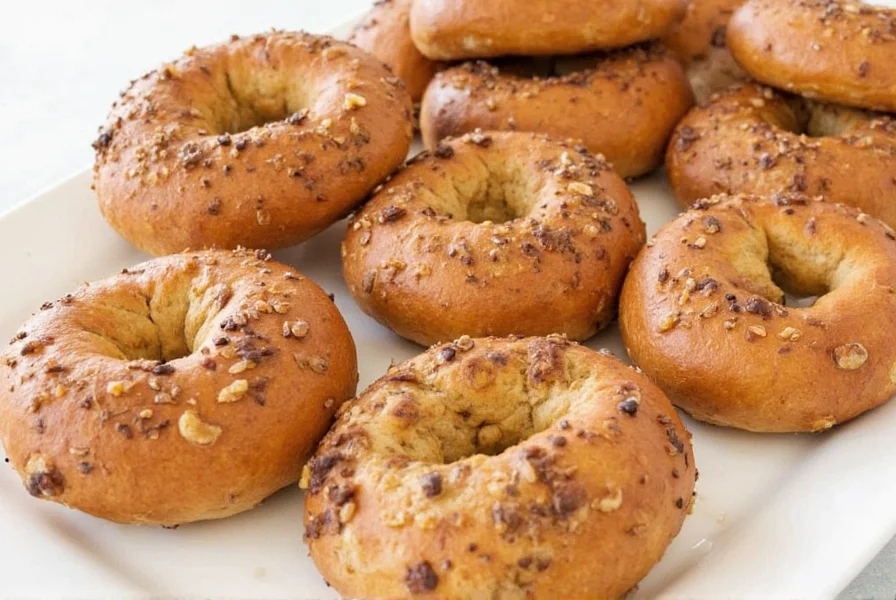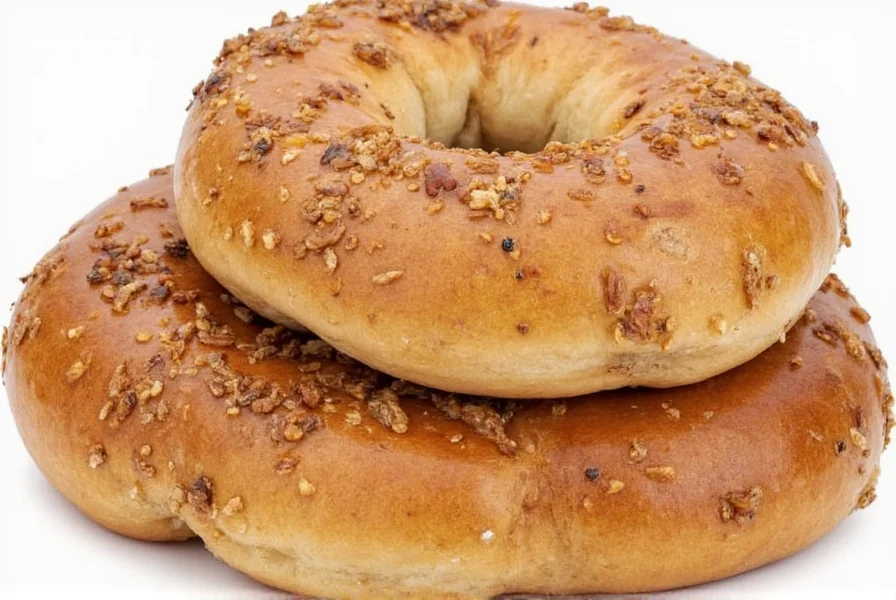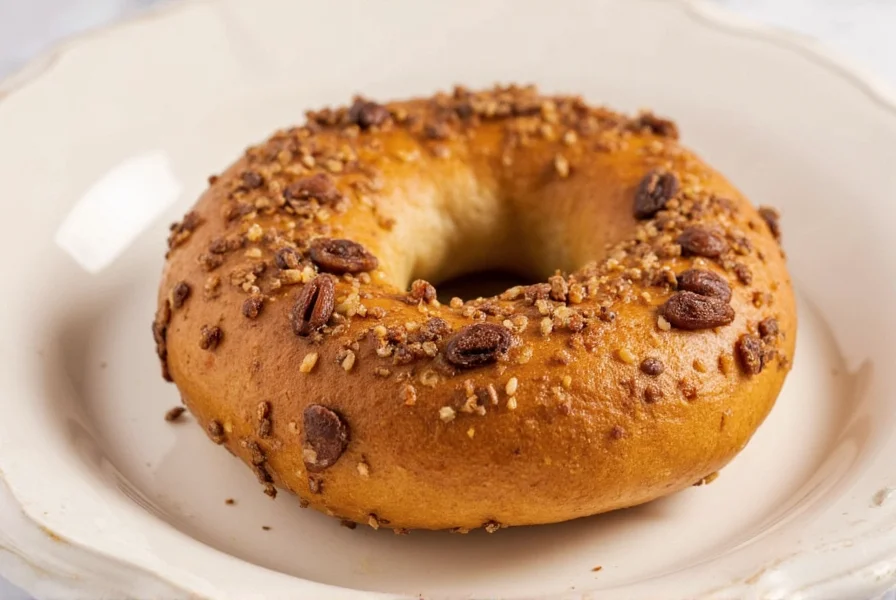Cinnamon raisin bagels represent one of the most beloved sweet bagel varieties, combining the satisfying chew of traditional bagel craftsmanship with the comforting warmth of cinnamon and the natural sweetness of plump raisins. Unlike plain or savory bagel options, this variety offers a dessert-like experience that has captured the hearts of breakfast enthusiasts nationwide.
The Unique Characteristics of Cinnamon Raisin Bagels
What sets cinnamon raisin bagels apart from other varieties is their distinctive marbled appearance and complex flavor profile. The cinnamon isn't merely sprinkled on top but is thoroughly incorporated into the dough, creating ribbon-like swirls of spice throughout. High-quality versions use real cinnamon rather than artificial flavoring, resulting in a warm, aromatic experience that complements rather than overwhelms the subtle sweetness of the raisins.
When properly made, these bagels maintain the essential chewy texture characteristic of all authentic bagels, with the raisins providing occasional bursts of concentrated sweetness. The best cinnamon raisin bagels strike a perfect balance—neither cloyingly sweet nor too subtle—making them versatile for both plain enjoyment and creative toppings.
| Characteristic | Traditional Bagel | Cinnamon Raisin Bagel |
|---|---|---|
| Texture | Dense, chewy | Slightly softer, chewy with fruit pockets |
| Sweetness Level | Minimal | Moderate to high |
| Primary Flavor Notes | Wheat, malt | Cinnamon, raisin, subtle sweetness |
| Best Serving Temperature | Warm | Warm or toasted |
Historical Development of Cinnamon Raisin Bagels
The story of cinnamon raisin bagels begins with Jewish immigrants in New York City's Lower East Side during the early 1900s. While traditional Eastern European bagels were strictly savory, American bakers began experimenting with sweet variations to appeal to broader tastes. The addition of cinnamon and raisins likely drew inspiration from traditional Jewish desserts like rugelach and babka.
By the 1950s, cinnamon raisin bagels had gained enough popularity to appear on menus at iconic New York bakeries. The variety truly exploded in popularity during the 1980s bagel boom when national chains began offering it as a standard option alongside more traditional varieties. Today, it consistently ranks among the top five most popular bagel flavors in North America.

Ingredients That Make the Perfect Cinnamon Raisin Bagel
The magic of a quality cinnamon raisin bagel lies in its ingredient composition. Authentic versions use:
- High-gluten bread flour for that signature chew
- Freshly ground cinnamon (not pre-mixed cinnamon sugar)
- Plump California raisins (soaked before incorporation)
- Malted barley flour for traditional flavor
- Natural yeast or sourdough starter for complex flavor development
Avoid versions where cinnamon flavor comes primarily from artificial flavoring or where raisins are hard and shriveled. The best cinnamon raisin bagels use a cinnamon swirl technique where the spice is layered within the dough rather than merely mixed throughout, creating those beautiful marbled patterns when sliced.
Taste Profile and Sensory Experience
When you bite into a well-made cinnamon raisin bagel, you experience multiple layers of flavor and texture. The initial impression is the slightly crisp exterior giving way to the dense, chewy interior. As you chew, the warm cinnamon notes emerge, followed by the sweet bursts from the plump raisins. The maltiness of the bagel dough provides a necessary counterbalance to the sweetness, preventing the experience from becoming cloying.
The ideal cinnamon raisin bagel shouldn't taste like dessert but rather like a sophisticated breakfast item with sweet elements. The cinnamon should be present but not overwhelming—more of a background warmth than a dominant spice. The raisins should be distributed evenly but not so abundant that they compromise the bagel's structure.
Perfect Pairings for Cinnamon Raisin Bagels
While delicious on their own, cinnamon raisin bagels shine when paired thoughtfully. Consider these combinations:
- Cream cheese variations: Lightly sweetened cream cheese, honey walnut, or plain Philadelphia-style
- Breakfast proteins: Scrambled eggs with chives or a side of bacon for contrast
- Beverage pairings: Strong coffee, chai tea, or cold milk
- Special preparations: Toasted with butter for enhanced sweetness or made into French toast
For those seeking the best cinnamon raisin bagels near me, look for bakeries that make them fresh daily rather than frozen dough. The texture difference between freshly baked and thawed bagels is significant, with fresh versions offering superior chew and flavor complexity.

Homemade vs. Store-Bought Cinnamon Raisin Bagels
While convenient, many commercial cinnamon raisin bagels compromise on quality. Mass-produced versions often contain high-fructose corn syrup, artificial flavors, and preservatives that mask the natural ingredients. The raisins may be hard and the cinnamon flavor artificial and one-dimensional.
For those interested in a homemade cinnamon raisin bagel recipe, the process requires patience but yields superior results. Key steps include:
- Soaking raisins in warm water or tea to plump them
- Carefully kneading cinnamon into the dough in layers
- Boiling in malted water before baking for authentic texture
- Baking until golden brown with a crisp exterior
Understanding cinnamon raisin bagel nutritional information is important for health-conscious consumers. While sweeter than plain varieties, they typically contain 280-350 calories each, with the raisins providing natural sugars and some fiber. When selecting options, check for minimal added sugars and artificial ingredients.
Finding Quality Cinnamon Raisin Bagels
When searching for the best cinnamon raisin bagels near me, consider these quality indicators:
- Freshness: Should be baked the same day
- Texture: Firm but yielding, with visible chew
- Appearance: Marbled interior with evenly distributed raisins
- Smell: Warm cinnamon aroma, not artificial
- Ingredients: Short list with recognizable components
Local artisanal bakeries typically produce superior cinnamon raisin bagels compared to national chains. The what makes cinnamon raisin bagels special is their balance of traditional bagel craftsmanship with thoughtful sweet enhancements that respect the integrity of the original food form.
Conclusion
Cinnamon raisin bagels represent a successful American adaptation of a traditional food, maintaining the essential qualities of authentic bagels while introducing appealing sweet elements. Their enduring popularity stems from this careful balance—neither dessert nor plain bread, but a satisfying middle ground that works for breakfast, brunch, or a sweet snack. Whether enjoyed simply with cream cheese or incorporated into more elaborate preparations, quality cinnamon raisin bagels offer a distinctive eating experience that continues to delight consumers more than a century after their creation.
Frequently Asked Questions
Are cinnamon raisin bagels traditionally made with cinnamon sugar or pure cinnamon?
Authentic cinnamon raisin bagels use pure ground cinnamon rather than cinnamon sugar in the dough. The sweetness comes primarily from the raisins, with any additional sugar being minimal. High-quality versions create a cinnamon swirl within the dough rather than mixing cinnamon throughout, resulting in those beautiful marbled patterns when sliced.
What's the best way to store cinnamon raisin bagels to maintain freshness?
For optimal freshness, store cinnamon raisin bagels in a paper bag at room temperature for up to 2 days. Avoid plastic bags which trap moisture and accelerate staling. For longer storage, slice and freeze in an airtight container for up to 3 months. Never refrigerate bagels as this speeds up the staling process. Always toast day-old bagels before eating to restore their ideal texture.
How do cinnamon raisin bagels differ nutritionally from plain bagels?
Cinnamon raisin bagels typically contain 30-70 more calories than plain bagels of the same size due to the added raisins and sometimes additional sugar. A standard cinnamon raisin bagel (about 3.5 ounces) contains approximately 320 calories, 1.5g fat, 65g carbohydrates, and 10g sugar, compared to a plain bagel's 280 calories, 1g fat, 56g carbohydrates, and 5g sugar. The raisins provide some fiber and natural sugars, but check labels as some commercial versions add significant amounts of sugar.
Why do some cinnamon raisin bagels have hard, shriveled raisins?
Hard, shriveled raisins in cinnamon raisin bagels typically result from improper preparation. Quality bakeries soak raisins in warm water or tea before incorporating them into the dough to plump them up. Mass-produced versions often skip this step to save time, resulting in dry, hard raisins that can even damage teeth. Another cause is using old or low-quality raisins that have lost their moisture content during storage.











 浙公网安备
33010002000092号
浙公网安备
33010002000092号 浙B2-20120091-4
浙B2-20120091-4